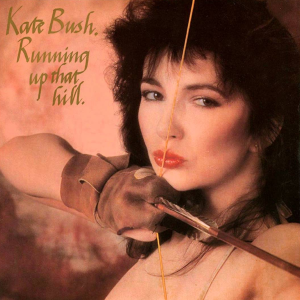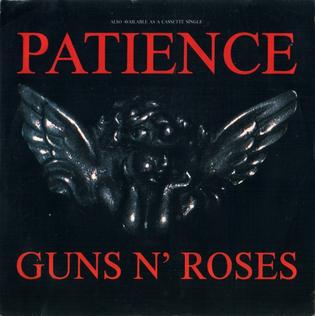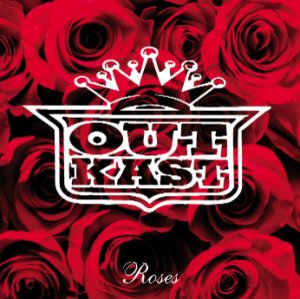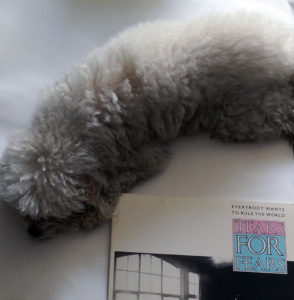
Inspired by the July 30 birthdays of Kate Bush, Paul Anka, Robert Clivilles, White Town, Frank Stallone, Sleeper’s Louise Wener, and Seth Avett; and the July 29 birthdays of Danger Mouse, Rush’s Geddy Lee, Gonzalez’s Lenny Zakatek and Onyx’s Big DS.

Inspired by the July 30 birthdays of Kate Bush, Paul Anka, Robert Clivilles, White Town, Frank Stallone, Sleeper’s Louise Wener, and Seth Avett; and the July 29 birthdays of Danger Mouse, Rush’s Geddy Lee, Gonzalez’s Lenny Zakatek and Onyx’s Big DS.

Inspired by the July 23 birthdays of Guns N’ Roses’ Slash, Depeche Mode’s Martin Gore, Tony Joe White, The Penguins’ Cleveland Duncan, Manhattan Transfer’s Janis Siegel, Travis’ Fran Healy, Orleans’ John Hall, David Essex, Alison Krauss, Starpoint’s Renée Diggs, and Blue Mink’s Madeline Bell.

Inspired by the May 27 birthdays of OutKast‘s Andre 3000, TLC’s Lisa “Left Eye” Lopes, Crowded House’s Neil Finn, Siouxsie Sioux, Spoonie Gee, Ramsey Lewis, Bruce Cockburn, Detroit Emeralds’ James Mitchell, and Vincent Price.

Inspired by the February 13 birthdays of New Order’s Peter Hook, Peter Gabriel, Robbie Williams, Feist, Black Flag’s Henry Rollins, Freedom Williams, the Monkees’ Peter Tork, Tennessee Ernie Ford, and songwriter Boudleaux Bryant, who, sometimes with his wife Felice, composed many of the Everly Brothers hits, including “Bye Bye Love,” “All I Have to Do Is Dream,” “Wake Up Little Susie,” “Bird Dog,” “Devoted To You,” and “Love Hurts.”
Today is the birthday of Peter Gabriel. It’s also the birthday of Peter Tork of The Monkees. And Peter Hook of New Order/Joy Division fame. Those three inspired today’s playlist of guys named Peter. Only on Tunes du Jour, folks. And before anyone drags me on social media for not including any women, I couldn’t think of any female Peters. #SorryBernadettePeters
Click here to like tunes du Jour on facebook!
Follow me on Twitter: @tunesdujour
Follow me on Instagram: @glennschwartz
One of 1987’s most popular and critically-acclaimed hits began its life as a demo recording named after the duo who sang “It’s Raining Men.”
It’s by the band U2, who referred to the track as “The Weather Girls” or “Under the Weather.” Their guitarist, The Edge, told Rolling Stone magazine that the song sounded like a reggae band’s version of Survivor’s “Eye of the Tiger.” Over time they developed the song. Instruments were added to the initial drum pattern. When it came time to come up with lyrics, The Edge gave singer Bono a piece of paper on which he had written a phrase that came to him earlier that day – “I Still Haven’t Found What I’m Looking For.”
That became the song’s title, with lyrics inspired by the gospel music Bono was listening to at the time. “I Still Haven’t Found What I’m Looking For” was U2’s second consecutive #1 single, following “With or Without You,” which was included on part 1 of Tunes du Jour’s Throwback Thursday – 1987 playlist.
Here are twenty of 1987’s best, kicking off not with The Weather Girls, but with U2.
Click here to like Tunes du Jour on Facebook!
Follow me on Twitter: @TunesDuJour
Follow me on Instagram: @GlennSchwartz
Early in the career of the group Dead or Alive, UK music magazine Melody Maker described their lead singer Pete Burns as “a cross between Bette Midler and Jim Morrison.” Sure.
At the time Burns was sharing a home and a bed with his wife Lynne and his lover Steve. His marriage with Lynne dissolved in 2006, the year he announced his engagement to a man named Michael.
Today Burns celebrates his 57th birthday. Tunes du Jour kicks off its weekly dance party with Dead or Alive’s “Brand New Lover,” with lead vocals by the man Melody Maker called a “transvestite sex symbol.” Sure.
Click here to like Tunes du Jour on Facebook!
Follow me on Twitter: @TunesDuJour
Follow me on Instagram: @GlennSchwartz
Tears for Fears, the duo consisting of Roland Orzabel and Curt Smith, released their debut album, The Hurting, in 1983. In their native England the album spawned three top five singles, “Mad World,” “Change” and “Pale Shelter.” In the US, their most successful single, “Change,” peaked at #73 on the Billboard Hot 100.
When it came time to do their second album, they wanted to break the US market. Needing one more song to round out the record, the duo’s producer, Chris Hughes, suggested Orzabel flesh out a song sketch he brought into the studio. Orzabel did so, and while he didn’t think much of the finished piece, Smith and Hughes thought this is the song that would change their fortunes stateside.
This song, “Everybody Wants to Rule the World,” was the first single released in the US from Songs from the Big Chair. It went to #1. The song that was the album’s first single in much of the world, “Shout,” was the second US single from the album, and the duo’s second #1.

Today, Curt Smith of Tears for Fears turns 55 years old. Tunes du Jour’s weekly dance party kicks off with a song on which Smith sings lead, Tears for Fears’ #1 breakthrough hit “Everybody Wants to Rule the World.”
Click here to like Tunes du Jour on Facebook!
Follow me on Twitter: @TunesDuJour
Follow me on Instagram: @GlennSchwartz
By 1986, Aerosmith appeared to have had their best years behind them. Sales of their releases that decade lagged significantly behind their hits in the 1970s, and the group’s members were struggling with drug addictions.
They did have fans, though. One was music producer Rick Rubin. He was working with rap group Run-D.M.C., who were known in hip hop circles and with music critics for incorporating rock guitars and beats in their boastful raps, such as “Rock Box” and “King of Rock.”
Rubin suggested Run-D.M.C. do a remake of Aerosmith’s 1977 hit “Walk This Way,” but the rappers had no interest in doing a cover. However, the group’s DJ, Jam Master Jay, was open to the idea, and Rubin called Aerosmith’s Steven Tyler and Joe Perry to come into the studio. Perry was familiar with the rappers, as his stepson was a fan. Jam Master Jay convinced Run and D.M.C. to give the remake a shot, seeing as Tyler and Perry were in the studio with Rubin.
The Run-D.M.C./Aerosmith version of “Walk This Way” was not only massively successful, but highly influential as well. It became Run-D.M.C.’s first crossover hit, and the first rap track to make the top ten of Billboard’s Hit 100, peaking at #4, six notches higher than Aerosmith’s original peaked. It opened the door to future song/rap collaborations, something that continues to dominate the charts to this day, not to mention bringing “rock rap” to a wide audience.
Steven Tyler went to rehab in 1986, and the other members of Aerosmith also sought treatment for their drug addictions. On the heels of the success of the “Walk This Way” remake, Aerosmith released the Permanent Vacation album in the late summer of 1987. Its first single, “Dude (Looks Like a Lady),” became the group’s first hit single outside the Run-D.M.C. collaboration since 1978’s “Come Together.” They followed that single with a string of big hits over the next few years, including “Love in an Elevator,” “Cryin’,” “Janie’s Got a Gun,” “I Don’t Want to Miss a Thing,” “Livin’ on the Edge,” and “Jaded.”
This week’s Throwback Thursday playlist spotlights the best of 1986, kicking off with the groundbreaking “Walk This Way,” performed by Run-D.M.C. and featuring Aerosmith’s “Steven Tyler and Joe Perry.
Click here to like Tunes du Jour on Facebook!
Follow me on Twitter: @TunesDuJour
Follow me on Instagram: @GlennSchwartz
During the 1980s, Siouxsie and the Banshees, led by Susan “Siouxsie” Ballion, had 15 top 40 singles in the UK, where they formed. In the US, they had 15 fewer hits.
That changed in 1991, thanks to a song about a popular Hollywood actress of the 1950s who died in a car accident in 1967.
Vera Palmer, under her screen name Jayne Mansfield, won the Golden Globe Award for New Star of the Year in 1957, beating out Natalie Wood. That was the year she appeared in the film Will Success Spoil Rock Hunter?, based on the Broadway show in which she also starred. She also starred in the hit film The Girl Can’t Help It, which featured appearances from Little Richard, Fats Domino, The Platters, Eddie Cochran and Gene Vincent.
Her career took a turn after these hits, perhaps due to a public backlash against her over-exposure, perhaps due to a decline in popularity of the “blonde bombshell” look, and/or perhaps due to her frequent pregnancies keeping her from accepting roles she was offered.
She did continue to work, however – in films, on television, on stage, and on records. Following a nightclub performance in Biloxi, Mississippi on June 28, 1967, Mansfield was en route to New Orleans where she was scheduled to be part of a radio show the following day. Her car collided with a tractor-trailer, and Mansfield, as well as her boyfriend and the car’s driver, were killed instantly.
The car accident is referenced in the fourth verse of Siouxsie and the Banshees’ “Kiss Them for Me,” named after Mansfield’s 1957 film in which she co-starred with Cary Grant.
“Kiss Them for Me” peaked at #23 on the Billboard Hot 100, nine positions higher than its UK peak. It also went to #1 on the Billboard Modern Rock chart and hit #8 on the Billboard Dance chart.
Today the woman born Susan Ballion turns 59 years old. Tunes du Jour’s weekly dance party kicks off with her ode to the late Jayne Mansfield.
Click here to like Tunes du Jour on Facebook!
Follow me on Twitter: @TunesDuJour
Follow me on Instagram: Glenn.Schwartz99